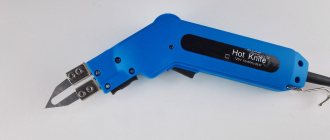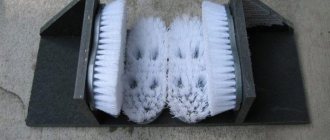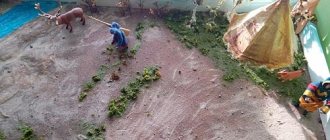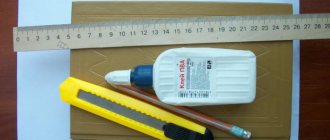Why a hook for fishing
This fishing attribute is always present among winter fishing enthusiasts, and especially among those who practice catching predators. Without a hook it makes no sense to go fishing at all. The fact is that pulling a large fish out of a hole is quite problematic, especially with bare hands, and even in the cold.
Without this simple device, it is difficult to cope with predators such as pike, pike perch, burbot, etc. in winter. The hook is also useful when fishing for large perch, carp, bream, etc. The mechanism of hooking is as follows: when the fish is already in the hole, it is caught with a hook on the lower jaw or gills.
The most important thing is that the hook is durable and does not let the fisherman down at the most crucial moment; in addition, the hook should not take up much space and fit freely in the fishing box. In this case, the hook can be made collapsible, which is the most practical and feasible.
Features of homemade pike baits
People have been making pike baits with their own hands since ancient times; during excavations, homemade products are still being found near river beds, which local residents used to catch fish. Many skills have been lost, but modern machines and devices have enabled craftsmen to make smaller and thinner baits.
Nowadays, making a bait for a predator with your own hands is not at all difficult for a person with certain skills, especially since handmade work has recently been highly valued. Most often made:
- turntables;
- vibrators;
- wobblers;
- spinnerbaits;
- foam fish.
Some people are capable of casting rubber, the size of which can vary greatly.
At first glance, homemade baits may look clumsy, especially those made of metal. But after the first cast and retrieve, anglers stop paying attention to the appearance. Many models of hand-made lures are passed down in the family by inheritance, so their work can be said to be tested over generations.
It is worth understanding that such products are produced both for open water fishing from the shore and on winter days from the ice.
Hook device
The general design of the hook can have a variety of designs, but its principle of operation is almost the same, which indicates the presence of a standard part. Any hook design consists of 2 main parts: a handle and a working part. The main material for making a handle is wood such as birch, ash, beech, maple, oak and others.
- The design of the handle is of no small importance, as is the quality of its manufacture. It must be carefully sanded and coated with water-repellent varnish or paint. A primer, which is rougher than enamel, will also be used for coating. The color of the coating is, of course, dark, so that the hook is easy to find in the snow. Naturally, it is not recommended to use metal to make a handle. In the cold, and even with water, your hands will instantly freeze to the instrument, even if they are wearing gloves.
- The working part of the hook is a metal hook made of steel wire, about 5 mm thick. A large fishing hook for catfish is suitable for making a hook.
Oscillating spoons
Spoon baits are excellent baits for catching pike. Its basis is a plate curved in a certain way, which allows the spoon to make characteristic movements in the water that attract predators.
- The simplest option for making a spinner for pike is to use a handle from a tablespoon made of stainless steel or cupronickel. The desired shape is obtained by bending the handle at both ends. At the same ends, holes are drilled for attaching the tee and the bait itself to the main fishing line. The tee is installed on the wider side. In general, this lure resembles a small fish, like a bleak.
- The remaining part of the spoon is also suitable for making a spoon. At the same time, you can immediately note that there is no need to bend anything and the spinner is almost ready, all that remains is to drill holes for attaching the tee and the winding ring.
- From the handle of an aluminum spoon you can make an analogue of the well-known and expensive spoon bait called “ Devon ”. The manufacturing technology is the same as for making a spinner from heavy metal, but the tee should be installed on the narrow part of the handle. By adjusting the bend of the handle, you can change the game of the bait.
- from the remaining part of the aluminum spoon , according to option No. 2. The only advantage of such a spinner is its ability to make certain sounds while moving. As a rule, the pike certainly reacts to this stimulus.
- Basically, oscillating spoons are made from blanks cut from plates of various metals. It can be oval, diamond-shaped or in the form of a willow leaf. A hole is drilled on one side for attaching the fishing line, and on the other side the hook is attached using soldering. Soldering allows you not only to secure the hook, but also to load the bait. But before this, the workpiece is given a special shape by stamping or embossing. On the side where no soldering was done, the surface of the spoon is carefully ground and polished. To make the manufacturing process faster, several blanks should be made and a ready-made stamp should be used. Then you just need to drill the necessary holes and secure the hooks.
- If you connect together two blanks made of different materials, you get a bimetallic spoon . One of the best options may be a copper-aluminum spoon, but it will not be durable, since these two metals are not friendly with each other. And yet, it can be made. To do this, you should prepare two absolutely identical blanks from copper and aluminum. To connect them, you can use the riveting method, after which the surfaces are ground and polished. Using the stamping method, the spoon is given the desired shape.
- From a metal tube a tubular spoon is made. To do this, take a tube of any metal of the required diameter, after which it is cut on both sides at different angles. After this, the outer part of the tube is ground and polished. Finally, mounting holes are drilled on both sides. The tee is installed from the more acute angle, and fastening to the fishing line is carried out from the blunt end. This will give the bait the necessary game.
- A greater effect can be obtained if the tubular spoon is made composite. As a rule, a spoon consists of three parts, which bend when the spoon moves, making it more attractive to a predator.
- from a corrugated plumbing tube , which may be more catchy than any other spoon. To make it, you need to take a corrugated plumbing pipe (shiny) and cut out suitable blanks from it, and then drill the necessary holes for fasteners.
- Oscillating spoons of small size ( ultralight ) are made using similar methods described in paragraphs 5 and 6. The only difference is in size.
Decoration of spinners
Plumage
The different colors that are located in the tee area play an important role. The bait becomes more attractive to fish, and it also camouflages the hook. Options are possible using vibrating tails or other silicone baits that are attached to the hook of the spoon. This approach allows you to make the spoon more catchy. Sometimes it is enough to add a fish eye or several stripes on the surface of the spoon and the spoon will play completely differently, which will undoubtedly increase the number of pike attacks on the bait.
How to make a hook for ice fishing with your own hands
Most avid fishermen practice making their own fishing equipment, tackle, bait, etc. Making a hook is also possible at home. It is not only simple, but also interesting, although you can simply buy it at the store. At the same time, it may happen that he will not be able to satisfy his buyer. As for making it yourself, the result will be the device you need.
To make such a product you will need the following tools and materials:
- A piece of wood for making a cylindrical handle, 25 mm in diameter and 200-300 mm long.
- A piece of steel wire up to 1 meter long and up to 5 mm thick.
- Car clamps.
- A couple of washers.
- Large catfish hook.
- Welding machine.
- Bulgarian.
- Electric drill.
- Primer for wood in a dark shade.
How to make a gaff with your own hands.
The manufacture of the device begins with the handle. The manufactured handle is attached to the working part in two ways:
- A through hole with a diameter of about 5 mm is drilled inside the wooden blank, along its body. A washer is placed on one edge of the steel wire and welded. After this, a wooden blank is placed on the wire, followed by a washer, which is also attached to the wire by welding. In conclusion, you should use a grinder to cultivate the welding areas. That's it, the handle is securely fastened.
- The second method is even simpler than the first. One end of the steel wire is bent at an angle of 90 degrees. In a wooden blank, across its body and at a distance of 5 cm from the edge, a hole with a diameter of 5 mm is drilled. The wire is applied to the handle so that the bent end of the wire fits into the drilled hole. After this, the wire is pressed with two clamps and that’s it, the handle is securely fastened. All that remains is to cover it together with the wire with a primer.
The second method, although simpler, is not very attractive from an ergonomic point of view. In addition, the presence of metal on the handle, along with clamps, is not an optimal solution.
After the handle is securely fastened, you can begin to form the working part, which can be done in two ways. For example:
First option
The wire can simply be bent. To do this, you should measure the size of the hook. The optimal length of this device can be in the range of 0.7-1 meter. Having measured the required length, the wire is bent with a radius of about 15 mm. The length of the bent part can be 70-80 mm, and the rest is cut off with a grinder. Using the same grinder, the curved end is sharpened so that it is sharp.
DIY telescopic hook
Second option
This method of manufacturing the working part involves the use of a welding machine. The point of production is that a large catfish hook is welded to the end of the wire. To do this, measure out the required piece of wire and cut off the excess with a grinder. A hook is attached to the end of this wire by welding.
To ensure that the hook takes up little space, it can be made of two parts. To do this, use the same grinder to cut the device in half, and cut threads at the cut points. After this, the ends are connected using a coupling with an internal thread, up to 50 mm long.
Fishing table with feeder
In order not to put bait and fishing accessories on the ground, you can make a bait table that will facilitate the fishing process and become useful for outdoor recreation. It is easy to place and keep bait, bait, attractants and other accessories on hand.
If we are already talking about such concepts as do-it-yourself feeder fishing, to make a table you will need the following consumables:
- a dining tray that will act as a tabletop;
- PVC pipes necessary for laying electrical cables;
- corners for connecting legs;
- plastic tips.
The frame base for the tray-table top is made from pipe. The base is secured with self-tapping screws, and the legs are mounted through the corners. Of course, you can weld a metal table, but the cost of manufacturing it will increase, and the weight will increase significantly.
Types of hooks for fishing
It would seem that the hook is a fairly simple device, and what other options might there be. In fact, there are several designs, and they are different. In addition to the fact that they come in both summer and winter, they also come in folding and non-folding types.
Folding hook
This type of gaff is ideal for winter fishing, since when assembled it takes up minimal space. It consists mainly of 2 parts, although any number of parts can be formed using this principle. The connecting elements are hinges, which allow you to move the gaff from the transport position to the working position.
Flexible hook
The design of such a device is different in that inside all the components there is a hole through which a cable passes, 3 mm thick. There is a tension device on the handle with which the cable is tensioned. As a result of tension, all components are pressed tightly against each other. This gaff is not cheap. Made from thin stainless metal.
Telescopic hook
This version of the hook has one significant advantage: you can adjust its length, depending on the fishing conditions. Similar designs are produced more for summer fishing. This is understandable, since the presence of water and frost can negate all its advantages.
Varieties of greenling
Individuals differ from each other very much. Thus, the single-lined greenling has one lateral line, the color is yellow, with brown spots on the sides. Due to its small size (the length of the fish does not exceed thirty centimeters), this species of harehead is almost never used in commercial fishing. In Russia, this type of fish is extremely rare.
The American greenling attracts fishermen much more, because its length reaches sixty centimeters. The dorsal fin of the individual is divided into two parts. The fish lives in the Pacific Ocean; the largest population of the species is located in the Gulf of Alaska.
The spotted greenling can be found in the Pacific Ocean. It is distinguished by its yellow-brown color, as well as green spots on its fins. An individual can grow up to fifty centimeters, the maximum weight is one and a half kilograms.
Read: Finta
The height of the red hare is sixty centimeters. This species is characterized by bright colors. The body is cherry, the fins are black, with a bright pink edging. The brown greenling is most often found in the Bering and Sea of Japan. The maximum length does not exceed thirty-five centimeters. The scales are dark yellow or brown.
The largest representative of the greenling belongs to the genus Ophiodon Girard, its length is about 1.5 meters, and its weight can reach sixty kilograms. The color of the scales is directly dependent on the type of soil on which the individual lives. The color varies from light gray to dark brown, with dark spots on the sides. This species of greenling is very attractive to commercial fishermen.
The weight of the northern jackrabbit reaches two kilograms; the fish lives in the northern part of the Pacific Ocean. The color is most often olive, with brown stripes.
Terpug is excellently caught using different types of gear; if the fisherman manages to find a place where a large population of fish lives, then the fishing will be a great success!
How to use a hook correctly?
It is unlikely that anyone would think that this tool also needs to be used correctly. This is especially true for those moments when you already need to hook a large fish. At such moments, the fisherman forgets about everything, as well as about what needs to be done at this moment. And yet, there are some rules that will allow this operation to be carried out without losing fish. Here they are:
- At these moments you should not fuss, making sharp and ambiguous movements. Composure and calmness are the guarantee of successful fishing.
- The hook should be lowered into the hole until the fish appears there.
- The fish should be hooked in the area of the front fins.
- The angler's movements must be deliberate and quick.
If the fish does not fit into the hole, then the hole should be widened, holding the fish with a hook.
Pocket safety hook
Real fishermen are, first of all, real craftsmen who constantly improve their fishing equipment, making them more practical. Bagorik did not go unnoticed by fans of fantasy and this is what came out of it.
To make such a device you will need:
- Telescopic antenna from an old radio.
- A couple of wine corks (maybe more).
- Hook for catfish (large).
- Some copper wire.
First you need to take a few wine corks. A hole is made through the entire body of the plug, with a diameter slightly less than the thickness of the first leg of the telescopic antenna. As a result, when all the plugs are put on the knee, you should get a light and comfortable handle.
Then take the hook and solder it to the end of the last bend. Whether to bite off the eye of the hook is a decision made by the manufacturer of the device. For reliability, it is better to wrap the soldering area with copper wire, which must be stripped of insulation. In this case, the eye of the hook can also be useful, which will contribute to a more secure fastening. That's all, the hook is ready for use.










